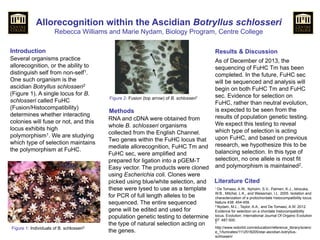B. schlosseri Poster
•Transferir como PPTX, PDF•
0 gostou•113 visualizações
Denunciar
Compartilhar
Denunciar
Compartilhar

Recomendados
Recomendados
Mais conteúdo relacionado
Destaque
Destaque (12)
Manufacturing Momentum: The Dayton Region and Beyond

Manufacturing Momentum: The Dayton Region and Beyond
Integrated Transport Competition - In field solutions elevator pitches (3 of 3)

Integrated Transport Competition - In field solutions elevator pitches (3 of 3)
Semelhante a B. schlosseri Poster
Semelhante a B. schlosseri Poster (20)
cloning. Second, it is sensitive. Activities canbe detected 

cloning. Second, it is sensitive. Activities canbe detected
Why Life is Difficult, and What We MIght Do About It

Why Life is Difficult, and What We MIght Do About It
Chapter 3BiopsychologyFigure 3.1 Different brain imagi.docx

Chapter 3BiopsychologyFigure 3.1 Different brain imagi.docx
Chapter 3BiopsychologyFigure 3.1 Different brain imagi.docx

Chapter 3BiopsychologyFigure 3.1 Different brain imagi.docx
892018 South Universityhttpsmyclasses.southuniversity.docx

892018 South Universityhttpsmyclasses.southuniversity.docx
1 What is the study systemGeneral information. E.g. What is a .docx

1 What is the study systemGeneral information. E.g. What is a .docx
B. schlosseri Poster
- 1. Allorecognition within the Ascidian Botryllus schlosseri Rebecca Williams and Marie Nydam, Biology Program, Centre College Introduction Methods Results & Discussion 1 De Tomaso, A.W., Nyholm, S.V., Palmeri, K.J., Ishizuka, W.B., Mitchel, L.K., and Weissman, I.L. 2005. Isolation and characterization of a protochordate histocompatibility locus. Nature 438: 454-459. 2 Nydam, M.L., Taylor, A.A., and De Tomaso, A.W. 2012. Evidence for selection on a chordate histocompatibility locus. Evolution: International Journal Of Organic Evolution 67: 487-500. 3 http://www.redorbit.com/education/reference_library/scienc e_1/tunicates/1112518205/star-ascidian-botryllus- schlosseri/ Several organisms practice allorecognition, or the ability to distinguish self from non-self1. One such organism is the ascidian Botryllus schlosseri2 (Figure 1). A single locus for B. schlosseri called FuHC (Fusion/Histocompatibility) determines whether interacting colonies will fuse or not, and this locus exhibits high polymorphism1. We are studying which type of selection maintains the polymorphism at FuHC. RNA and cDNA were obtained from whole B. schlosseri organisms collected from the English Channel. Two genes within the FuHC locus that mediate allorecognition, FuHC Tm and FuHC sec, were amplified and prepared for ligation into a pGEM-T Easy vector. The products were cloned using Escherichia coli. Clones were picked using blue/white selection, and these were lysed to use as a template for PCR of full length alleles to be sequenced. The entire sequenced gene will be edited and used for population genetic testing to determine the type of natural selection acting on the genes. Literature Cited Figure 2: Fusion (top arrow) of B. schlosseri1 Figure 1: Individuals of B. schlosseri3 As of December of 2013, the sequencing of FuHC Tm has been completed. In the future, FuHC sec will be sequenced and analysis will begin on both FuHC Tm and FuHC sec. Evidence for selection on FuHC, rather than neutral evolution, is expected to be seen from the results of population genetic testing. We expect this testing to reveal which type of selection is acting upon FuHC, and based on previous research, we hypothesize this to be balancing selection. In this type of selection, no one allele is most fit and polymorphism is maintained2.